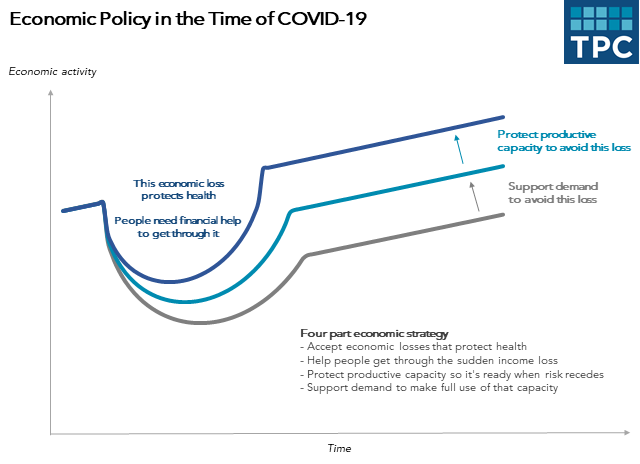COVID-19 poses a severe threat not only to public health but also to the overall US economy. The nation’s policy response should focus on four basic strategies.
First, we should embrace those economic losses that protect health. The steps needed to combat the coronavirus will inevitably reduce economic activity. We want risky activities to stop. Social distancing is in. Gatherings are out. Reducing economic activity will reduce the overall size of the economy. But we all know Gross Domestic Product is not a measure of social wellbeing. That’s especially true today.

Second, we should help people get through this sudden financial shock. Millions of workers will see their incomes fall from reduced work hours, furloughs, and layoffs. Restaurants, bars, and many other small businesses will see their revenues crater.
Expanding existing safety net programs—as the House-passed Families First Coronavirus Response Act does for unemployment insurance, Medicaid, and food assistance—is a good start. So is supporting paid sick leave. But those programs miss many people.
That’s why we are seeing new proposals to get money out the door quickly. Making direct payments to households—recently proposed by Jason Furman (former economic advisor to President Obama), Greg Mankiw (former advisor to President Bush), and now Senator Mitt Romney (R-UT)—is one approach. Targeting payments to low-income households, as Australia is doing, is another. Giving money to employers who keep workers on their payrolls is a third. Whichever approach we take, a priority is getting support out quickly to soften what may be an unprecedented loss in income.
Third, we should protect our economy’s productive capacity so it can rebound once the virus risk recedes. COVID-19 shouldn’t destroy otherwise healthy businesses and nonprofits.
The Federal Reserve will play a role by ensuring smooth functioning of credit markets. Adding liquidity to Treasury markets, as the Fed is doing, is a good step. It may well take more steps in the days ahead. But that won’t be enough.
Congress and President Trump should help fundamentally healthy firms that are facing sudden cash flow stress and lack good financing options. Lending to small businesses is a natural first step. Trump has proposed expanding lending authority by the Small Business Administration. Other nations have announced similarly-focused programs. The United Kingdom, for example, has introduced new business interruption loans.
What to do for larger businesses is a harder question. Many large businesses do have private financing options. Or would if they had managed their balance sheets better. Expect spirited debate about where to draw the line between good and bad bailouts and, for that matter, about what constitutes a bailout. (I’ll have more to say about that in another post.)
Fourth, we should make full use of our economy’s productive capacity once the virus recedes. Rebounding supply will help only if demand keeps up.
The Fed has taken a first step to support demand by cutting its target interest rate to effectively zero and expanding its purchases of Treasury bonds and mortgage-backed securities. Those steps will soften the decline in consumer and business spending.
Whether that will be enough is anyone’s guess. With effective actions now, the economy may rebound quickly once the virus threat abates. Unfortunately, it’s also possible that economic activity will lag. If that happens, fiscal policy can help boost demand. The actions we take now to provide income support will help and could be continued. We also have the usual arsenal of tax (e.g., lowering payroll taxes) and spending (e.g., aid to states) options.
In recent days, America has made great strides in the first strategy, embracing the economic losses necessary to fight the virus. In coming days, the priority will shift to the next two, helping people survive the resulting sudden income loss and defending our productive capacity so it can rebound quickly. Policymakers may also take initial steps to support demand to make full use of that capacity. But the ultimate scope of those efforts will need to track the still-unknown size of the longer-term challenge.
